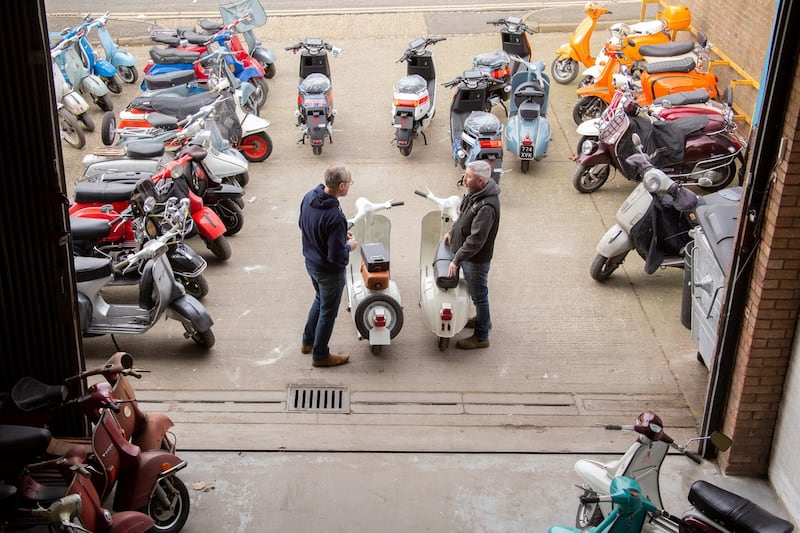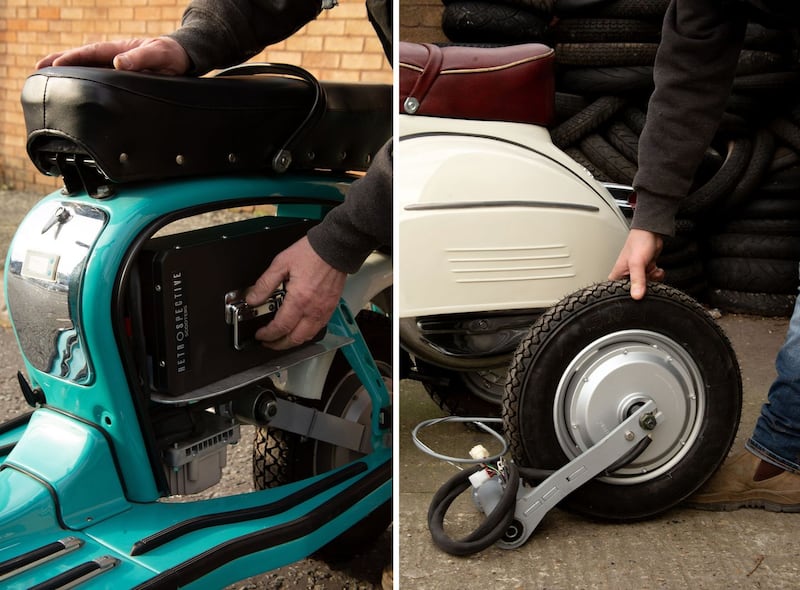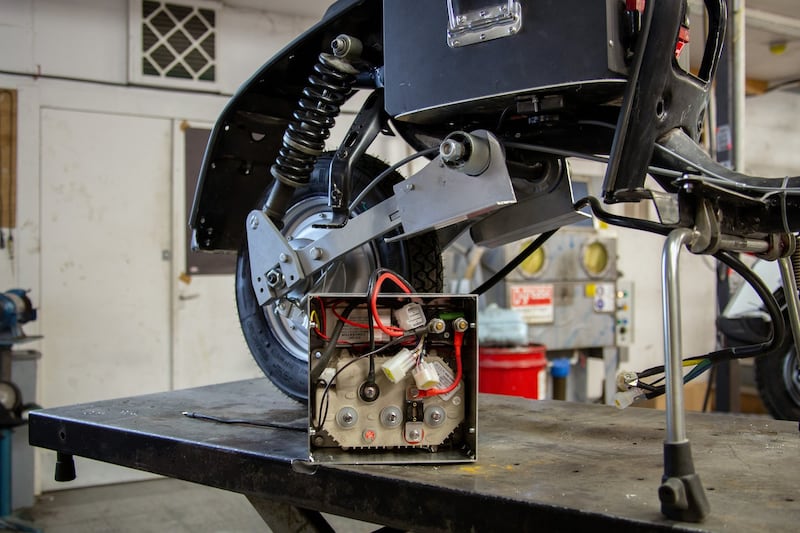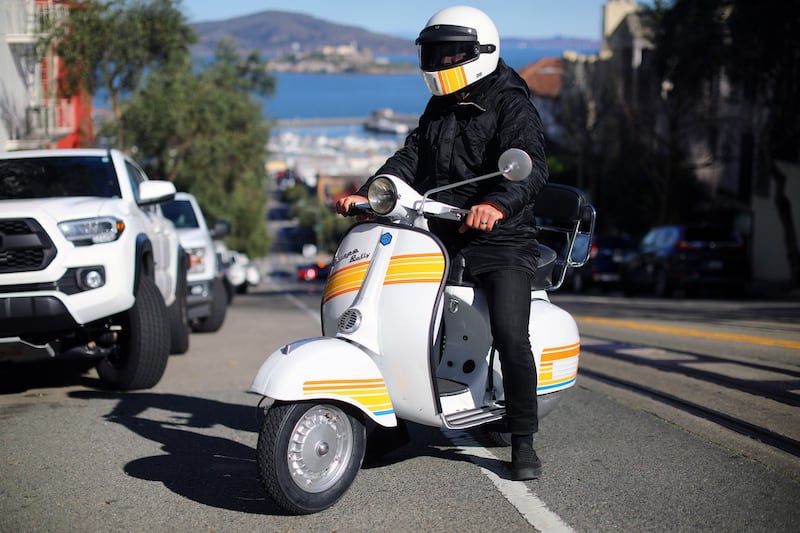Among the iconic designs of Italy's vibrant postwar period, few capture the essence of La Dolce Vita like Vespas and Lambrettas, the free-spirited motor scooters that brought mobility to the masses and became beloved across Italy and, subsequently, the world.
While the two companies still make scooters, those early models – whose whining two-stroke engines spew plumes of aromatic smoke – are by far the most sought by collectors, some commanding up to €25,000. But just as vintage scooters are reaching a new peak of popularity, a wave of emissions regulations aimed at reducing pollution threatens their access to Europe’s city centres. Within every regulation, though, lies an opportunity, and one lifelong scooter enthusiast has seized it firmly by the exhaust pipe.
The conversion 'was not to interfere in any way with the original design and setup of the scooters. You don't do any cutting or welding or destruction of the original chassis'
Niall McCart, who is from Armagh, got his first Vespa at 16. De rigueur for a youth swept up in the early-1980s Mod revival, the Vespa was eminently practical as well. "A two-stroke is a very simple mechanical structure," McCart says, with a modesty common to the mechanically gifted. "I could fix it with a screwdriver and a hammer" – an ability that would eventually serve him well on rallies along the English coast and on extended tours of Europe and India.
In 1989, at the age of 21, McCart moved to London, where, after stints in the building trade and delivering packages on a Vespa, he began working as a mechanic at a scooter shop. In 2000, he opened his own concern in a garden shed. Today, his business, Retrospective Scooters, occupies a 325sq m warehouse in Walthamstow, in east London.

As McCart’s business grew, so did restrictions on older vehicles. The European Union’s first low-emission zones were established in 1996. By 2018, there were more than 260, and still rising. London has one such zone, as well as an extra-stringent ultra-low-emission zone, in the city centre. Introduced in April 2019, the more stringent zone will expand substantially this October. To drive inside it, owners of polluting scooters must pay a daily fee of £12.50, or almost €15, or face hefty fines.
In 2017, with the end of cheap and dirty scootering looming, McCart posed a question to a friend and fellow scooter enthusiast, John Chubb: "Wouldn't it be great if we could make our old Vespas electric?" Chubb recalls the moment vividly. "We were sitting in a tent in a music festival in Cornwall, and he was saying the future is electric. I said, 'I reckon I could build one of those.'"
He could also bring a raft of technical competencies to the project. A retired Royal Navy commander with degrees in electrical engineering and rocket science, Chubb is also an expert in anti-ship missiles, a qualification whose benefit, though perhaps unquantifiable, couldn’t hurt.
'These guys were purists,' Niall McCart says. 'They were against it when they seen it, but as soon as they drove it they had the biggest grin on their face'
McCart’s brief was explicit. The conversion “was not to interfere in any way with the original design and setup of the scooters”, he says. “You don’t do any cutting or welding or destruction of the original chassis.” And, critically important for preserving a scooter’s value, the process had to be reversible.
An encounter with a Chinese manufacturer at a motorcycle show in Milan in 2017 proved instrumental. “The Chinese have been riding electric scooters for 15 years-plus,” McCart says. “They’ve done it and made it and perfected it. They had it all laid out.”
Chubb, meanwhile, hobnobbed with the chief technical officer of QS Motor, a firm in Zhejiang province that makes motors for electric scooters and ebikes. "We had a really good conversation," Chubb says. "I'd done a whole load of first-principles calculations about the power of an electric motor and how that would work in an electric scooter. I saw all his equations, and he and I did it exactly the same way.
“Seeing that data was very interesting,” he continues, “because we knew exactly where the sweet spot was in terms of the specifications of what we wanted to run as a motor, and we could run it more or less to optimum efficiency.”

McCart and Chubb devised the basic plan: pull the petrol tank and put a lithium-ion battery in its place, and replace the scooter’s original swing arm (which supports the engine and rear wheel) with a custom-made swing arm that holds a wheel with a built-in hub motor.
Chubb set to work on the prototype, meeting periodically with McCart, who fine-tuned various components. In June 2018, McCart unveiled their creation – an electrified 1976 Vespa Primavera – at the Vespa World Days rally in Belfast.
The initial reaction was sceptical. “These guys were purists,” McCart says. “They were against it when they seen it,” he recalls, “but as soon as they drove it to the other end of the car park and back again, they had the biggest grin on their face.”
One rider made a pivotal suggestion: “You’ve got to sell it as a kit.” McCart, who had planned to offer electric conversions only as a service, embraced the idea. “I thought, He’s right: I’ve got to make it really simple. The next step was to try and make a plug-and-play kit.”
Three years later, Retrospective Scooters sells kits for five types of vintage Vespas and Lambrettas. Costing about €4,000, each includes a 64-volt, 28-amp-hour battery that can push a scooter to a top speed of 80km/h and go 50km to 55km on a charge.

Certain scooters can accommodate two or three batteries. A Lambretta GP, for instance, packed with three lithium-ion units can go almost 195km between charges. McCart, though, thinks a single battery is sufficient. “Let’s not forget what scooters were invented for – travelling in a 20-to-30-mile radius of where you lived,” he says.
Last summer, Danny Montoya, the owner of a children’s woodworking studio in San Francisco, installed a kit in his 1973 Vespa Rally 180. Montoya had owned the scooter since 1999 but in recent years had grown uneasy with its pollution, not to mention the constant reek of petroleum.
A capable do-it-yourselfer, he initially considered cobbling together his own electric kit with information gleaned from internet message boards, but when he came across McCart’s, he says, he thought, “Whoa, this guy has actually done the work.”
Although the price gave him pause, after corresponding with McCart, who promised to assist with any technical issues, Montoya said, “Okay, this is legit.”
Montoya estimates he spent 20 to 30 hours on the project, the most complex part of which, he says, was ensuring that all of the electrical connections were correct. McCart acknowledges that at the time, in late 2020, the installation guide was rudimentary. Since then, he explains, the design of the kit and the instructions have been improved so that someone with basic mechanical skills should be able to complete the installation in about 16 hours.

These days, Montoya seeks any excuse to ride his electrified machine, which performs just as advertised, delivering 50km on a charge, even on San Francisco’s hills. Recalling his first ride, Montoya says, “It was very weird. A normal scooter is so loud, all you hear is the motor. This is so quiet, all you hear is the wind.”
On a recent afternoon, as Montoya did a few drive-bys, a reporter struggled to discern which was louder: the soft hum of the motor or the sound of the tyre treads licking the pavement. The new incarnation is so stealthy, in fact, Chubb finds that “when you live in a quiet village, people walk right in front of you”. He is looking into noise generators that could produce anything from the thrum of a Harley-Davidson to the futuristic racket of a Star Wars podracer.
McCart, who commutes every day on his electrified Vespa, takes a different approach to unwary pedestrians: “I shout at them. I say, ‘Oi!’” – New York Times









